Helping Your Child with Achromatopsia
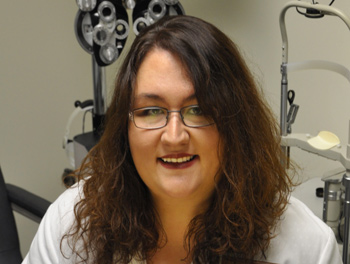


Laura K. Windsor, O.D., F.A.A.O.
The Low Vision Centers of Indiana
We encourage patients or family members to submit tips or strategies that have helped them or their child. Also please email us your questions. Submit these to Dr. Laura Windsor at drlaura@eyeassociates.com.
Getting Control of the Light
No single action is as important for most achromats as controlling the light. Once the light is controlled, your child’s vision problems become much easier to resolve.
Your child will benefit from the appropriate filtered eyewear. Each child  should be tested to determine which filter, the appropriate darkness and the type of frame to be used to help control the light.
should be tested to determine which filter, the appropriate darkness and the type of frame to be used to help control the light.
Most will require both a dark inside pair and usually an even darker eyewear for outside. The right filter outside is not the right filter inside! Outside bright light is usually 150 to 350 times brighter than inside bright light and as much as 2500 times brighter than a dim inside room. If made too dark, the inside filter may reduce reading ability. Children with achromatopsia should either have separate outside and inside eyewear or a filter that can be added over the top of their inside tint.
Sunwear may require a tighter fit with side panels to block light from leaking around the lenses outside.
When your child is old enough, soft contact lenses with special filters can be considered to allow the child to control glare and appear more natural with their peers. These should be fit by 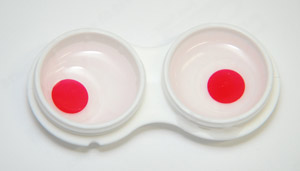 a doctor, specializing in low vision who is also experienced in achromatopsia contact lens techniques. The correct filter must be carefully determined. Your child will still require sunglasses outside, but often a more natural filter color can be used over the contacts.
a doctor, specializing in low vision who is also experienced in achromatopsia contact lens techniques. The correct filter must be carefully determined. Your child will still require sunglasses outside, but often a more natural filter color can be used over the contacts.
Fitting your child into soft contacts at the appropriate age, can lessen the psychological impact that red tinted eyeglasses create by drawing attention to your child’s challenges, especially in adolescent years.
The filters in eyewear or contact lenses will vary. Most rod monochromats find darker reds effective, while some patients prefer other colors of filters. In blue cone monochromats, the color magenta which allows some blue light through may be the best filter. Using the wrong filter can block the small amount of color vision that some patient’s have. The darkness of the filter is also critical.
Dark tinted windows in your car can be very helpful. In some states, you may require a statement from your doctor.
Keep an assortment of hats or visors that your child is comfortable wearing. Selecting hats that your child likes is crucial. Keep an extra hat in your car and at school, so your child will always have one available.
Pull down shades can be used on side windows in your car.
Most children with achromatopsia have a significant eyewear prescription, but some children may not accept wearing the correction. Encourage your child to wear it, but do not force your child. If necessary, provide a non-prescription filter carefully modified to fit the child’s light sensitivity. In cases of high hyperopic corrections, starting with a partial prescription may be helpful.
Below, we see a child with rod monochromatism in three situations. First without filters, the child has difficulty keeping her eyes open in normal bright inside lighting. Next, we see the inside filter which allows her to be comfortable in inside bright lighting. The third picture shows the darker sun filter in a sun frame that blocks all light coming in from the sides.
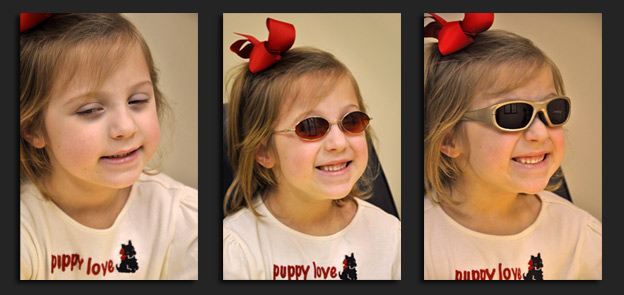
No one tint can handle both levels. One pair will either be too light outside or too dark inside.
In selecting eyewear frames, wrap-around styles may work better. It is critical to lessen lighting coming around the lenses.
In older children the new wrap-around sunglasses, such as the Wiley's sun filters used by our military, fit snug around the eyes and face and have slip foam inserts to block any light leaks. They can be made with or without prescriptions.
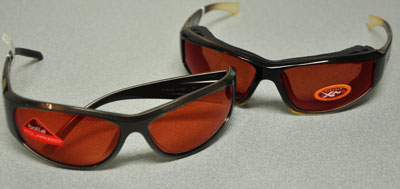
Exploit the Night
“She’d climb up on top of her toy box at night, open the curtains, and just stare out the window at the sky. She loved to look at the moon and clamored to play outside at night. Yet her days were full of hazards. She’d stumble over things when she was outside. She would step carefully around shadows, thinking they were holes. Once she fell off a patio and broke her leg.”
Mother of Achromat
Woman’s World June 1993
The nighttime is usually the best time for your child. The world opens up to them in the low light. Try to plan trips to parks, fairs, theme parks, zoos and other events at night. Organize holiday celebrations in the evening.
 Christmas lights at night and Trick or Treating at Halloween will be more enjoyable times for achromats.
Christmas lights at night and Trick or Treating at Halloween will be more enjoyable times for achromats.
Plan picnics and parties in the evening rather than in the bright sun.
Your child will see the stars at night. The peripheral rod cells are very sensitive to the low illumination of the night sky.
Design a safe nighttime play space outside your home. Let your child help you modify it until your child is comfortable.
Teach your child about things that can be fun at night like astronomy or catching fireflies  A small hand-held telescope can be fun at night and can be used in school.
A small hand-held telescope can be fun at night and can be used in school.
Wait for lower light before playing catch or basketball outside.
Consider attending outside sporting events at night such as an evening baseball game.
Arrange to have your child’s friend over in the evenings to play.
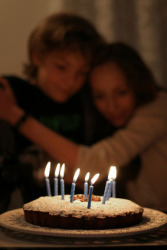
Schedule birthday and other parties in the evenings.
Take your child on regular walks in the evening.
Take your child out to ride a bike in a safe area in the evening, just after sun down. Be sure that your child has a helmet and protective eyewear in biking.
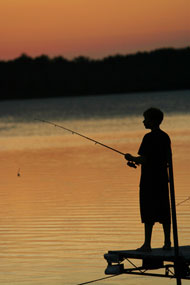
Taking trips to parks at night for a picnic can be much more enjoyable for your child. Your child can enjoy nature without be hampered by the bright light of day.
Fishing just after dusk can be fun for achromats. Be sure your child is safe with a life preserver and flashlight.
Create Great "Dark" Spaces for Your Child
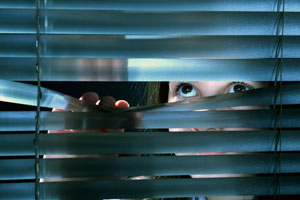 Add shades and drapes to allow tight control of lighting at home. Eliminate “hot spots of lights”, like a set of French doors without shades or a window behind the television.
Add shades and drapes to allow tight control of lighting at home. Eliminate “hot spots of lights”, like a set of French doors without shades or a window behind the television.
Dining rooms are often bright and often associated with windows. Add curtains to control glare. Seat your child with the child's back to the brightest light exposure.
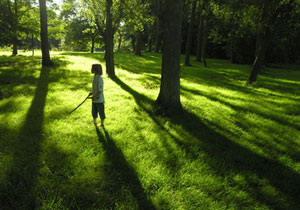 Create the child’s room in a way that controls light, but be sure to involve your child for what the child likes.
Create the child’s room in a way that controls light, but be sure to involve your child for what the child likes.
North facing rooms may be better for your child. Plan before you buy or remodel.
Add shade trees around your home, since the darker, the better. Awnings can also help.
"I remember once when she was 18 months old and not yet wearing really dark tinted lenses outdoors – I took her to a park, where she was unable to move about independently until I placed her under a small grove of trees. She really came alive then and became independent (for obvious reasons), toddling from tree to tree, hugging and kissing each trunk, examining the gnarly roots of each one."
- Member Achromatopsia Network
Create a workspace away from bright windows with rheostat light controls and dark matte surfaces on counters.
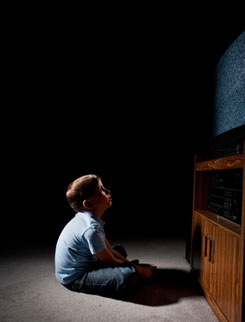
Use rheostat light controls as much as possible to allow your child to adjust the control of lighting levels. Incandescent lights are usually better received.
Design a playroom such as a basement where light is fully controlled. Create a refuge from the bright light, a room or an area, which can be kept dark. This can be a place where your child can to go to relax and reduce stress.
TV rooms should not have light behind the television and the TV brightness should be adjusted if needed to fit the child.
If your child goes outside and runs into a hot spot, it will impair them. In addition to shade, install fences or rows of shrubs that block the low sun in the east in the morning and the west in the evening.
Don’t Let Color Become Too Big an Issue.
Don’t let friends or relatives challenge your child's color vision by asking if they see “that color.” This can embarrass and stigmatize the child.
"It's frustrating when people tease me and test me on colors that I can't see. Some kids don't understand how much that hurts my feelings."
- Meirva Malter
Do not force your child to adopt special adaptations to handle color, but  provide help as the child shows an interest or asks for help.
provide help as the child shows an interest or asks for help.
Let your child color and draw with whatever colors they like. Encourage drawing and painting. But, understand you may see unusual color selections like green hair or yellow tires.
There is variability in rod monochromats. Some maintain a trace of some color vision. And if you have two children with achromatopsia, you may find slight differences in their color vision.
When your child asks for help or color-coding is needed in school, colored markers can be labeled. These colors don’t have meaning initially to the child but rather are differences in darkness which is used by the child.
Children learn to associate types of colors that are light, medium or dark with certain groups of colors. For example, a child learns that a dark color is used to color tires and a light color for the sun. Some colors like black and red may always appear the same to your child. Sometimes very different colors like red and black cannot be differentiated.

Don’t let your child’s color vision loss show up in the child’s clothes. You can purchase clothes that easily match. You can organize them by location in the closet or sew a small label inside the clothes such a unique letter or shape that indicates a match. For example, “B” matches with other “B”. Clothes that go together can also be kept together. Blue jeans are a wise choice since they can go with almost everything.

Explain to family and friends that your child's vision is like a beautiful black and white photo.
Remember some children with rod monochromatism have some small traces of color vision often for just one type of color. Blue cone monochromats do have some residual color vision, but it does not mean they see blue as others do. Objects colored blue may be easier to see.
Encourage visual arts like photography and drawing. Show your child both black and white photos and color photos and talk with your child about what you and your child see.
Introduce your child to drawing with charcoals that eliminate the color issue.
Help your child at buffets. Colors help us distinguish the types of food. Buffets can be difficult for young achromats.
Helping the School Help Your Child
Achromatopsia is rare enough that your child’s teachers have probably never taught an achromat. If they have worked with other low vision children, they may need to learn that some of the strategies used for other low vision students, like adding more light may be detrimental to your child.
Knut Nordby in his autobiographic story discussed his early bad experiences in school systems in the 1950s, and finally praised the teacher who adapted to his needs.
“I had the unforeseen fortune of having a teacher who had an understanding for my handicap and who really tried to help me overcome my problems in class. He was in many ways a very progressive teacher, ahead of his time. He did not adhere to the strict regime practiced in the schools in those days. As an example he let me move my desk up close to the blackboard so that I could actually see what was written, breaking the regular geometric order of the desks in the classroom, then so much cherished by the other teachers, and he let me move around in the classroom during lessons so that I could inspect at close quarters things that were demonstrated; something completely unthinkable with his colleagues who put their pride in having their pupils sitting quietly at their places. And he made a habit of always telling us what he wrote on the blackboard, which was of great help to me.”
Knut Nordby Night Vision Basic Clinical and Applied Aspects R.F. Hess, L/T/ Sharpe & K Nordby
Be sure your child has a visual impairment teacher (VI teacher) monitoring your their education. The VI teacher can evaluate your child's educational needs and help secure materials for the classroom. The VI teacher can help the other teachers understand your child's needs.
Ask that your teacher visit this site at www.achromatopsia.info to learn more about achromatopsia.
Develop an IEP (individual educational plan) with the school and your child's VI teacher. This is required, but what is included can vary. You need to be your child's advocate to have listed any needed services.
Some parents learn early to create their own packet of information about teaching their child. This can be given annually to everyone who will be working with your child.
 Insist on good contrast and quality for your child's paperwork, and ask the teacher to photocopy and enlarge your child's papers.
Insist on good contrast and quality for your child's paperwork, and ask the teacher to photocopy and enlarge your child's papers.
Ask your child's teacher if you can call him/her at home when issues come up. Frequently, there will be problems such as color coding or fatigue on a long homework project. These can often be solved with a quick phone call to slightly change the assignment.
Your child may benefit from wearing a hat or visor at school.
The child should be allowed to sit closer to the board, but with the child’s back to windows.
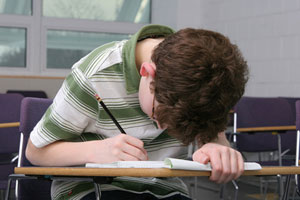
Explain to the teacher that your child may need to read and write at a very close distance.
The child should be allowed to walk up to the board to see the board better.
Bright white boards will be difficult to see owing to the amount of reflected light. If a chalk or marker board is used, determine which colors can be seen best.
Ask the teacher to limit or modify tasks that require color-coding such as a fill pattern of lines by pen rather than using colors. Colored markers can be labeled to let the child do simple color-coding tasks. Color-coded map projects are usually difficult. Work out how these will be handled. Your child could do a pattern to fill in versus a color or use labeled markers.
Explain that nystagmus can increase or decrease based on stress and this will reduce vision temporarily.
Ask the teacher to allow use of a bold pen or marker like the Sanford 20/20 pen. It will be much more visible than a pencil. Avoid pencils!
Advise the teacher that your child will generally see darker colors better in the brightness of a classroom. Pastels should be avoided.
Teach the child to use a paper, ruler or Read Easy overlays to keep the child’s place when the child looks up and down. Read Easys are yellow acetate sheets with a black line across the sheet.
Explain to the teacher that visually impaired children frequently are hesitant to admit they are not seeing something on the board, and may not approach the board as they do not want to look impaired. The teacher must check to see that the child is doing ok without drawing attention to the child.
Timed tests may not be accurate. Allow additional time for all quizzes and tests.
Avoid glare on desktops by using a dark matte material on the desk.
Sometimes the volume of schoolwork may cause such fatigue that it can overwhelm the child. If your child is fatigued in school or during homework, try to reduce the volume of work without sacrificing the quality. Ask the teacher to determine if doing three of a particular type of math problem versus five to ten of the same problems could be adequate. We do not want the child to avoid the work, just to adjust the workload slightly if possible to reduce eyestrain.
Place classroom displays lower on boards so your child can get close enough to see them.
Ask the teacher to use some black poster board as a background for posted pictures and charts. It will improve visibility.
Books on tapes are generally not well accepted by many achromats in childhood. Young children have good focusing ability, and if glare is controlled they can bring the reading closer and do well.
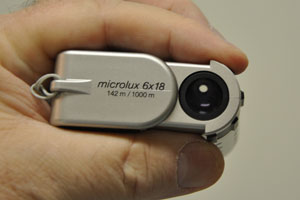
A small handheld monocular telescope can be helpful in spotting the chalkboard, and is usually well accepted by the child and peers. In fact, all the children want to play with the monocular. A non-round scope is advised so that it will not roll off the desk.
"When kids around me found out, they were vicious. I kept it all bottled up inside. Now I use that when I paint. Now I don’t get chastised. I get complimented."
- Jay Lonewolf, Painter
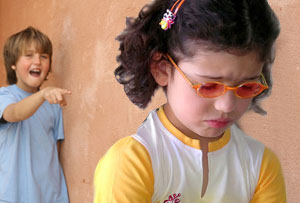
Bullying and harassment are common when children appear “different”. The school needs to determine how it will monitor and treat such situations. Prevention by education is always better. The classmates should be educated about the child’s problem. We cannot emphasize enough how serious teasing and bullying can be for children with achromatopsia. Our patients of all ages talk about how they were treated by other children and some misguided adults.
"It's frustrating when people tease me and test me on colors that I can't see. Some kids don't understand how much that hurts my feelings."
- Meirav at age 8
Your child should be excused from going outside into the sun for recess. Alternate play areas should be developed.
Request that your child have the option of brief breaks when very fatigued. This can lessen increased nystagmus and accommodative fatigue.
Large print books may not be required for all achromats. Some children reject them, owing to the large size of the books and the aspect of being different from peers. Many children reject it because if the glare is controlled they can often read normal print, but at a close distance. The VI teacher can assess this need. Be sure the child can do this without fatiguing.
Large print books can also be heavy for the child to carry. When large print books are used, we recommend two sets, one at school and one at home.
Bifocals may help reduce the eyestrain of reading at a very close distance in many achromats. The point at which bifocals might be considered varies with each child. Any indication of eyestrain in school work should lead to consideration of bifocals, reading eyewear, or other low vision aids. Some achromats do not accept bifocals and will do better with separate reading glasses.
When possible, control light in the classroom with drapes or shades. Sometimes the light above the child’s desk can be turned off.
Until your child can do it with their own organizational skills, organize and review your child’s clothing before going to school to avoid embarrassment from mismatched colors.
Advise the teachers that your child is not “BLIND”. Those words should not used. Describe the words you feel comfortable with, like visual impairment or low vision.
Emphasize that this is not a progressive condition! Explain this not just to teachers, but to family and most importantly to your child. Stress to the teacher that the child can function well, if we control the light.
Request that class notes be printed out for your child in large print. 
The best color paper for your child to see should be determined and the teacher asked to provide this for your child. White paper can cause additional glare and light issues for your child.
Ask that shades be placed on windows near your child and sometimes overhead lights can be removed from one fixture.
If the classroom is too bright, ask for a resource room with subdued lighting where the child can occasionally work.
Meet with your child’s teachers regularly.
In older children, ask that your child can be allowed to use the Internet for research versus the library which is often more difficult for achromats.
Be sure your child's IEP plan is up to date and reflects the current needs of your child.
Summer camps for the visually impaired can be great but too often, the amount of sunlight may overwhelm your child. Know the area, amount of shade and the types of events planned.
Computers are the Great Equalizer
Encourage your child to learn to use a computer. Develop keyboard skills as early as possible. Use a dark keyboard, and apply key caps with large white letters over a dark background. Be sure the desk surface is dark in color and non-glossy.
Control glare sources above and behind the computer display. A bright light or window behind the computer can create a major glare problem for your child. Even a bright wall can cause problems. Place a dark surface like a piece of black matte poster board behind the computer. You might paint the wall darker.
Invert contrast on the monitor to white letters on a dark or black background.
Teach your child how to use the universal access magnifier built into most computer's operating systems that provide th option to enlarge fonts and reverse contrast (white letters on black background).
Adjust the brightness of the display to better fit your child's comfort.
Consider an inexpensive Microsoft magnifying mouse for spot enlargements.
Use a larger high contrast LCD monitor 22 inches or bigger.
If needed, add enlarging software like ZoomText or WinZoom. USB thumb drive versions are available that can be plugged into any computer being used.
Low Vision Aids
The most important low vision aids are the tinted lenses, sunwear and filtered soft contacts. These items allow control of the light and make it possible for all the other low vision options.
Young children may not be able to be fit with the filtered contact lenses. From about age 9 and up, the ability to fit these lenses increases. Younger children can be fit, if the parent is able to handle insertion and removal and the child is emotionally ready to wear contact lenses.
The patient below shows the difference with and without the Red Filtered Contact Lenses. Notice that the squinting is immediately eliminated inside. This picture was taken within minutes of putting on the red filtered contact lenses.
The Red Central Lenses

Once the contact lenses are fit, the child will not require the dark tinted lenses inside, and can now wear a more normal colored sun lens outside.
There are many types of low vision aids. A young child will have much more focusing ability, and thus may be more comfortable just holding things closer. A small non-lighted magnifier including a dome type magnifier are often helpful. They are non-lighted and sit on the desktop like a paper weight. They are well accepted by many young achromats.
A bifocal can be helpful for many children. When a child reads very close it requires a great effort to focus (accommodate) their eyes. The bifocal may make your child more comfortable.
A small hand-held video magnifier may be more effective for your child since it limits the amount of glare compared to a full 22 inch video magnifier. Video magnifiers produce more contrast and with a black background with white letters may reduce the glare on reading materials.
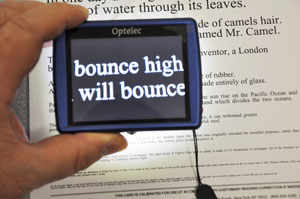
A small hand-held telescope or monocular can aid in seeing the chalk board or white board and are well accepted by the child's peers.
Sports and Recreation
Outside physical education should generally be avoided, but every child should be evaluated individually to give them the option to participate with their peers as much as possible. With adequate sunwear, some activities may be possible.
The school should provide some alternate physical activity that can be done out of the sunlight.
If your child swims, goggles can be created with dark tints in them.
Inside sports like martial arts can also be a good inside sport option for achromats.
Sports that involve fast moving objects like baseballs and tennis balls can be dangerous as the child may not see the fast moving ball coming towards them. These sports become even more dangerous in bright light.
In bright sunlight even with sunglasses, the visual fields may narrow from the squinting by the child.
Depth perception is the first visual skill lost in visual impairment. This can make it harder for your young child to catch a ball or shoot a basket. Overtime the child will develop a functional sense of depth. It will be worse in the bright light.
Activities like kickball can be difficult if the brightness of the ball matches the asphalt of the play area. A bright light colored ball can allow your child to play.
Tinted sports/safety eyewear should be used when physical sports are selected.
Adolescent Issues
Cosmetic appearance is crucial in older children and no one wants to be different from their peers. The new types of soft lenses can solve this problem of cosmetics while providing better vision. While red filters are the most effective, we can use a brown filter and simply convert a blue-eyed patient to brown eyes.
In older children, begin to look at bioptic driving options so the child will know if this important option may be there one day. This varies by state. See our section on driving and our sister website www.BiopticDrivingUSA.com to learn more about bioptic driving.
College will greatly increase the volume of reading required of your child, and open them to more glare issues on a large campus. See your low vision specialist before college to look at the steps needed to get a good start in college.
Avoid Self Fulfilling Prophecies
“Most people refer to my blindness as a disability. To me the word "disabled" means you are "unable." I am by no means unable.”
Rachel Scdoris, Dog Sled Racer
In our practice, we have provided care for achromats including school superintendents, factory managers, pharmacists, writers, college graduate students, administrators, college professors, civil engineers,a dean of a medical school and business managers. The most famous achromat, Knut Nordby was a scientist, and Rachel Scdoris is an outstanding athlete and Iditarod dog sled racer. In fact, we have noticed how accomplished most of our achromat patients are in the world.
Don't expect less than the greatness you should expect of any child.
Do not let your child think they are in anyway less intelligent than any other child. Often, visually impaired children may start behind other children in the early grades, owing to the early impact of their vision. This should not be misinterpreted as reduced intellectual potential. Once their vision problems are corrected, they often surge ahead in school.
Don't let teachers assume your child will not be as successful as any other child. If your teacher has an innate misperception that your child will be limited, it can become a self fulfilling prophecy.
Challenge your child to succeed just as you would any other child. Never let others treat your child as limited in intellectual ability. You only ask for reasonable accommodations to control light, color and low vision. Be sure your child is seeing a low vision specialist at least yearly.
